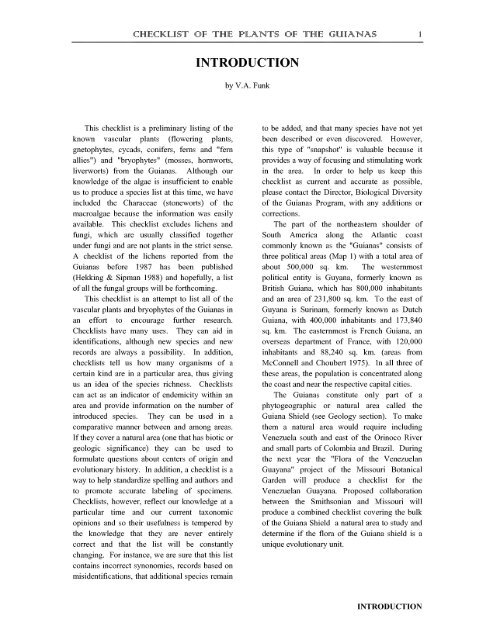APPENDIX A. Contributors and reviewers. - si-pddr - Smithsonian ...
APPENDIX A. Contributors and reviewers. - si-pddr - Smithsonian ...
APPENDIX A. Contributors and reviewers. - si-pddr - Smithsonian ...
You also want an ePaper? Increase the reach of your titles
YUMPU automatically turns print PDFs into web optimized ePapers that Google loves.
CIHECKLKST OF TlHllE PILANTS OF iriHllE (GlUilANAS<br />
This checklist is a preliminary listing of the<br />
known vascular plants (flowering plants,<br />
gnetophytes, cycads, conifers, ferns <strong>and</strong> "fern<br />
allies") <strong>and</strong> "bryophytes" (mosses, homworts,<br />
liverworts) from the Guianas. Although our<br />
knowledge of the algae is insufficient to enable<br />
us to produce a species list at this time, we have<br />
included the Characeae (stoneworts) of the<br />
macroalgae because the information was ea<strong>si</strong>ly<br />
available. This checklist excludes lichens <strong>and</strong><br />
fungi, which are usually clas<strong>si</strong>fied together<br />
under fungi <strong>and</strong> are not plants in the strict sense.<br />
A checklist of the lichens reported Irom the<br />
Guianas before 1987 has been published<br />
(Hekking & Sipman 1988) <strong>and</strong> hopefully, a list<br />
of all the fungal groups will be forthcoming.<br />
This checklist is an attempt to list all of the<br />
vascular plants <strong>and</strong> bryophytes of the Guianas in<br />
an effort to encourage further research.<br />
Checklists have many uses. They can aid in<br />
identifications, although new species <strong>and</strong> new<br />
records are always a pos<strong>si</strong>bility. In addition,<br />
checklists tell us how many organisms of a<br />
certain kind are in a particular area, thus giving<br />
us an idea of the species richness. Checklists<br />
can act as an indicator of endemicity within an<br />
area <strong>and</strong> provide information on the number of<br />
introduced species. They can be used in a<br />
comparative manner between <strong>and</strong> among areas.<br />
If they cover a natural area (one that has biotic or<br />
geologic <strong>si</strong>gnificance) they can be used to<br />
formulate questions about centers of origin <strong>and</strong><br />
evolutionary history. In addition, a checklist is a<br />
way to help st<strong>and</strong>ardize spelling <strong>and</strong> authors <strong>and</strong><br />
to promote accurate labeling of specimens.<br />
Checklists, however, reflect our knowledge at a<br />
particular time <strong>and</strong> our current taxonomic<br />
opinions <strong>and</strong> so their usefulness is tempered by<br />
the knowledge that they are never entirely<br />
correct <strong>and</strong> that the list will be constantly<br />
changing. For instance, we are sure that this list<br />
contains incorrect synonomies, records based on<br />
mi<strong>si</strong>dentiflcations, that additional species remain<br />
INTRODUCTION<br />
by V.A. Funk<br />
to be added, <strong>and</strong> that many species have not yet<br />
been described or even discovered. However,<br />
this type of "snapshot" is valuable because it<br />
provides a way of focu<strong>si</strong>ng <strong>and</strong> stimulating work<br />
in the area. In order to help us keep this<br />
checklist as current <strong>and</strong> accurate as pos<strong>si</strong>ble,<br />
please contact the Director, Biological Diver<strong>si</strong>ty<br />
of the Guianas Program, with any additions or<br />
corrections.<br />
The part of the northeastern shoulder of<br />
South America along the Atlantic coast<br />
commonly known as the "Guianas" con<strong>si</strong>sts of<br />
three political areas (Map 1) with a total area of<br />
about 500,000 sq. km. The westernmost<br />
political entity is Guyana, formerly known as<br />
British Guiana, which has 800,000 inhabitants<br />
<strong>and</strong> an area of 231,800 sq. km. To the east of<br />
Guyana is Surinam, formerly known as Dutch<br />
Guiana, with 400,000 inhabitants <strong>and</strong> 173,840<br />
sq. km. The easternmost is French Guiana, an<br />
overseas department of France, with 120,000<br />
inhabitants <strong>and</strong> 88,240 sq. km. (areas from<br />
McConnell <strong>and</strong> Choubert 1975). In all three of<br />
these areas, the population is concentrated along<br />
the coast <strong>and</strong> near the respective capital cities.<br />
The Guianas constitute only part of a<br />
phytogeographic or natural area called the<br />
Guiana Shield (see Geology section). To make<br />
them a natural area would require including<br />
Venezuela south <strong>and</strong> east of the Orinoco River<br />
<strong>and</strong> small parts of Colombia <strong>and</strong> Brazil. During<br />
the next year the "Flora of the Venezuelan<br />
Guayana" project of the Missouri Botanical<br />
Garden will produce a checklist for the<br />
Venezuelan Guayana. Proposed collaboration<br />
between the <strong>Smithsonian</strong> <strong>and</strong> Missouri will<br />
produce a combined checklist covering the bulk<br />
of the Guiana Shield a natural area to study <strong>and</strong><br />
determine if the flora of the Guiana shield is a<br />
unique evolutionary unit.<br />
INTRODUCTION
















